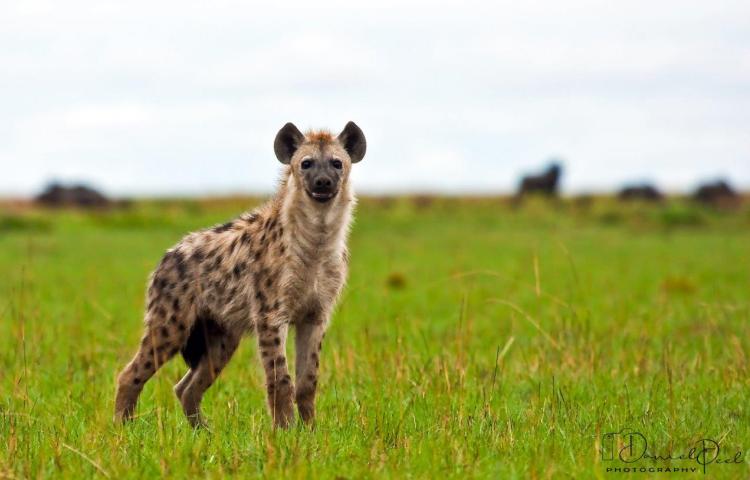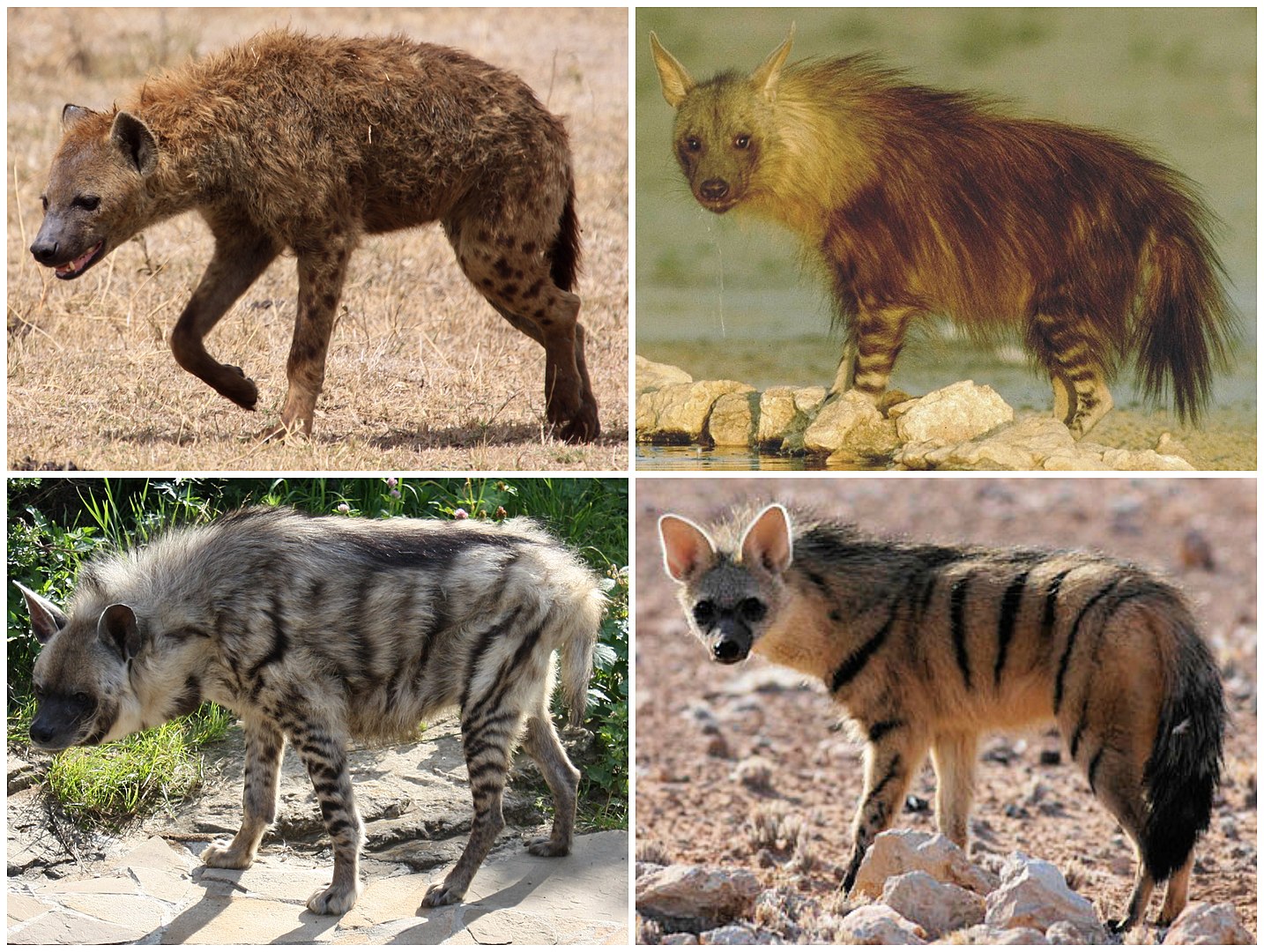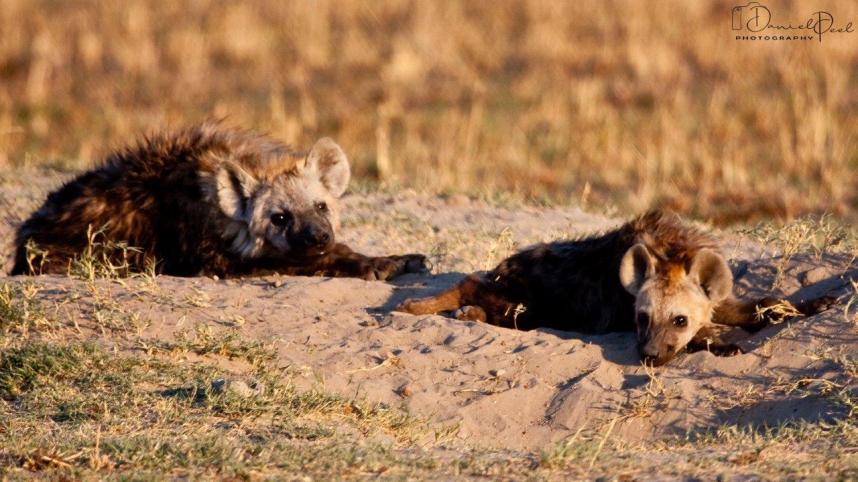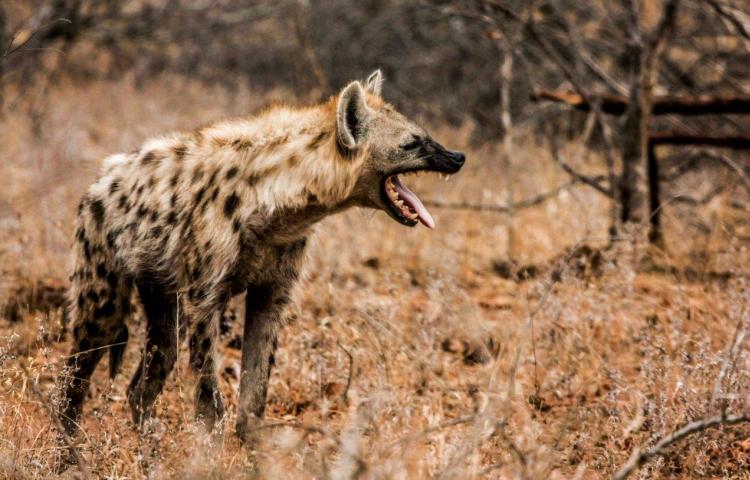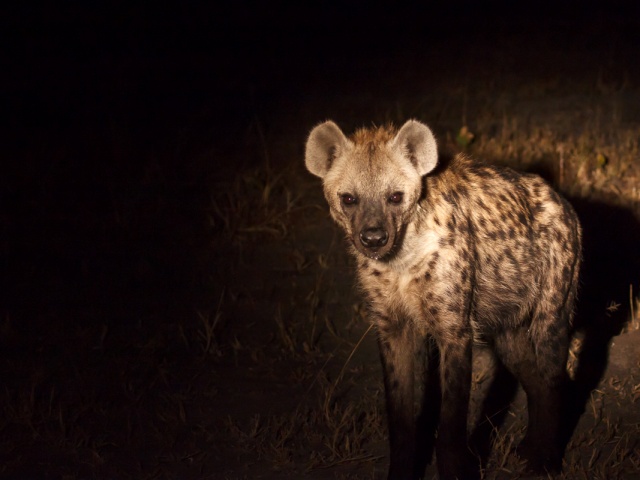African HyenaHyena are incredibly social and complex animals. They are often given a bad name as dirty scavengers that skulk around in the darkness. This is not true; they are very successful hunters and in some areas, lions will actually scavenge from hyena.
African Hyena
Quick Facts
Latin name: Crocuta Crocuta How Many African Hyena Species Are There?There are four species within the Hyaenidae family. The largest is the most well-known- the Spotted Hyaena (Crocuta crocuta). The Brown Hyaena (Hyeana bunnea) roughly the size of a large dog has a long shaggy coat and is very secretive. The Striped Hyaena is found in North and East Africa, with a beautiful striped black and brown coat. The last member is much smaller than the other three, weighing a meagre 12kg (26lbs) and standing little more than 50cm (20in) at the shoulder. Their diet is unique- living exclusively on termites- The Aardwolf (Proteles cristatus).
African hyenas. Top left: Spotted Hyena. Top
right: Brown Hyena. Bottom left: Striped Hyena. Bottom right: Aardwolf. In this article, we will cover the most common and well-known species; the Spotted Hyaena. Where Do African Hyena Occur?Once widespread throughout large tracts of Africa, only being absent from dense forests and extreme desert areas, their distribution is now very much confined to protected wildlife zones. Being viewed as pests, often killing livestock around farming areas they have been heavily persecuted in the past. However, these incredibly intelligent animals are cunning and have been able to survive and even thrive in adverse conditions. Their distribution really comes down to the presence of medium-sized herbivores, which make up a large portion of their hugely varied diet.
The Spotted Hyena What is the African Hyena Clan Structure?Highly intelligent creatures, their cognitive abilities have been compared to primate species. Living in a matriarchal pack also known as clans, they are led by the alpha female. Below her is an intricate hierarchical system with higher and lower-ranking individuals fighting to gain position within the clan. However, in this female-driven society, any female automatically outranks any male. Clan sizes vary hugely dependent on food availability. In semi-desert areas where food is scarce clans may only number 5 or so individuals, however, in areas such as the Masai Mara in East Africa where prey species are plentiful, they form the largest pack of predators on the planet, numbering 130 strong they are a force that can wipe savannahs clean in a single night. Are African Hyena Nocturnal?Nocturnal animals by nature, they will rest during the day near the den, in thick bush or undergrowth. As night takes over the hyaena will start becoming active; often meeting up at the den sites and pre-forming their intricate social greeting and rituals before heading out in different directions to forage for the night. In this way, the clan can cover more territory in a night. If a 'scout' finds a small meal, he will keep quiet and wolf it down as quickly as possible before moving on. If a large prize is spotted, he will call for back-up with a long-distance eerie whooping call that can be heard from up to 6 or 7 km (3.5 to 4.3 mi) by humans, much much further by the keen hearing of a hyaena. Do African Hyena Hunt?Hyena are incredibly successful hunters, adopting an endurance type of hunt rather than the stalk and ambush type that lions are known for. Their body shape, large forequarters with a downward sloping back towards small hindquarters means they are perfectly designed for stamina. Once they pick out an animal from a herd they will try to single it out and chase it away from the protection of the others. Once they have their prey alone, they will chase it down over kilometres, being able to keep up their top speed of 60 km/h (40mhp) for up to 5 km (3 mi). Working together as a unified unit, once the lead hyaena tires or falters, a new fresh member of the pack will take the lead and push the prey even harder. Eventually, their quarry can't keep it up and succumbs to exhaustion. Being intelligent creatures, hyena will always go for the easiest meal that requires the least amount of energy to obtain. This does often mean stealing the hard-earned prizes from other predators. Leopard and cheetah are easily harassed and generally chased off by a single hyena. However, lions do not give up so easily. At least double the weight of a large hyena, battles between these eternal enemies have become famous. A clan of hyena only really have a chance of intimidating lions if they number them at 4 to 1, overwhelming them with numbers. Large male lions can be close to 4 times the weight of hyena and often don't tolerate them around. Usually, if there is a male lion around hyenas keep their distance.
Laughing hyena Do African Hyena Occur in Victoria Falls?As already mentioned hyena are an incredibly successful species. This is no different in Victoria Falls where hyena are prolific. However, as they are a nocturnal species they are not seen that often and the best chance of seeing one is to do a night drive.
Hyena seen on a night drive The town of Victoria Falls is surrounded by national parks and wildlife areas, so hyena, at night or in the early hours of the morning, often venture into the streets in town, sometimes scavenging on the waste left in rubbish bins. Their eerie and whooping call is a common sound in the evenings and is synonymous with the African night.
|
|
||
|
|
|||
|
|
|||
|
| |||
